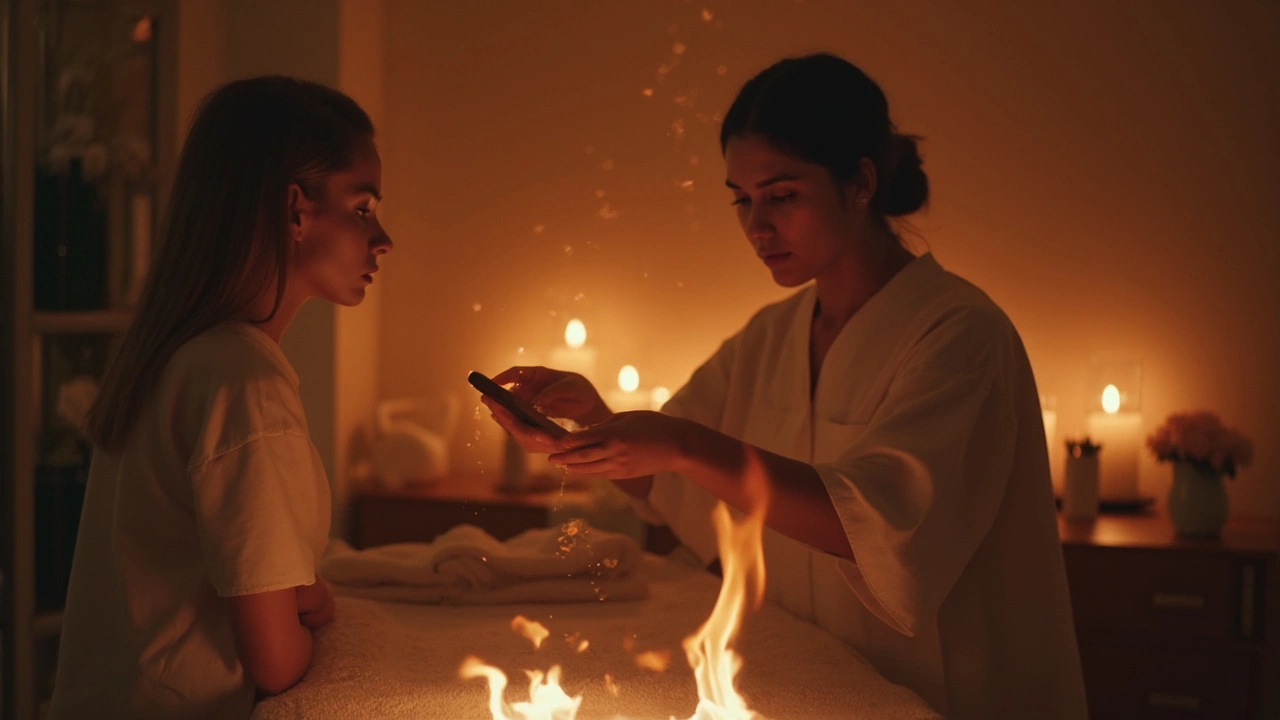Fire Massage: Why This Spa Experience Is Worth Trying
 Apr, 20 2025
Apr, 20 2025
If you’re picturing an old-school spa room with dim lights and quiet music, now add open flames to the mix. Fire massage is exactly what it sounds like—heat therapy taken up a notch, using quick bursts of fire combined with oil and towels. Sounds wild, right? But it’s a real thing, and it’s way safer than it looks.
People who love deep heat treatments say fire massage leaves their muscles feeling loose and their brains less wired. Ever struggled with tension you just can’t shake? Fans of this technique swear that it melts away the kind of stress regular massages can’t touch.
Now, before you get visions of fire dancing wildly across your skin, relax—professionals actually use careful steps to keep it safe and painless. Want to know how it all works, what it actually feels like, or if it’s even the right fit for you? Stick around. We’ll break down what to expect before you ever step foot in the spa.
- So, What Exactly Is Fire Massage?
- How Fire Massage Actually Works
- Real Benefits: More Than Just Heat
- Is It Safe? What You Need to Know
- Tips Before You Book Your Session
So, What Exactly Is Fire Massage?
Alright, let's get straight to it—fire massage is not just someone waving a lighter around and calling it therapy. This is an old-school technique, especially popular in China and parts of Southeast Asia, but popping up now in fancy spas worldwide. The process is all about using controlled, short bursts of flame combined with oils and towels, creating a deep, consistent heat you can't get from a heating pad alone.
Here's how it usually works: the pro massages your body with special herbal oils first. Then, they put layers of thick towels on your back or wherever you need treatment. Next, they soak another towel in alcohol or a flame-safe solution, light it up just for a few seconds, and glide it over the body using the towel barrier. You feel warmth, not burning. The whole thing looks scarier than it feels. Most people report it as a cozy, intense heat, kind of like a strong hot stone massage.
What makes fire massage different from the usual spa stuff? Besides the obvious (fire!), it supposedly helps blood flow faster and relieves muscle soreness deeper than regular heat-based massages. It’s that punch of heat that really gets into stubborn tension spots.
"Fire massage therapies are designed to combine traditional massage with fire’s unique heat, creating rapid muscle relaxation and stress release that many find unmatched," says Dr. Jade Liu, a Beijing-based wellness expert quoted in Spa Industry Weekly.
Here’s a quick look at how fire massage stacks up against common spa treatments:
| Technique | Main Tool | Average Session Time | Typical Sensation |
|---|---|---|---|
| Fire Massage | Flame/Towels/Herbal oils | 40-60 mins | Intense heat, deep relaxation |
| Hot Stone Massage | Heated stones | 60 mins | Gentle, steady warmth |
| Swedish Massage | Hands/lotions | 60-90 mins | Mild to moderate pressure |
So, if you’re looking to supercharge your next spa experience or just curious about what’s out there, fire massage is a legit—and surprisingly soothing—option to check out.
How Fire Massage Actually Works
Curious how a fire massage even happens without third-degree burns? Here’s the real deal. The therapist starts by soaking a thick towel in a mix of special herbs, alcohol, or essential oils—depends on the spa and their own twist on tradition. They lay this damp towel on your back, then place another dry one on top as a barrier to keep you safe but still get the heat through.
Here’s where it gets wild: They pour a little bit of high-proof alcohol on the top towel and set it on fire. Don’t freak out—the flames usually last just a few seconds, and the therapist stands ready with wet towels to smother the fire instantly. The real goal? Letting the heat quickly open up your pores and send warmth deep into your muscles—way deeper than a regular hot stone could manage.
- Your skin never touches the flames directly. There’s always a solid barrier.
- The burning part usually lasts 10 to 20 seconds at a time, repeated as needed on different areas.
- After the fire, therapists use traditional massage techniques while your muscles are warm and pliable.
A 2022 safety review in the Journal of Alternative and Complementary Medicine found, “Trained professionals using the correct method and safety barriers provide a largely pain-free and injury-free experience.” So, it really comes down to the skills and training of the therapist.
“A skilled fire massage therapist never rushes the steps. They’re dialed in to your comfort and the exact flame timing,” says Dr. Max Chen, a Chinese medicine practitioner featured in Health Spa Monthly.
Let’s look at the key steps most spas follow for fire massage sessions:
- Set up the towels and oils on your chosen body area.
- Apply the alcohol solution for the quick flame.
- Light the fire and carefully monitor the heat.
- Extinguish the flames, then work the treated muscle area using deep tissue techniques.
Some spas even offer a quick aftercare application of cooling gels or herbal balms as a bonus, making sure you leave feeling refreshed and safe. If you’re thinking about booking a fire massage as your next spa experience, just make sure to ask about their safety protocols up front.

Real Benefits: More Than Just Heat
Most folks think fire massage is just about feeling warm, but it goes way beyond that. When done by someone who’s been properly trained, it actually targets deep tissue and ramps up blood flow quicker than regular hot stone massages. You know that heavy, tight feeling in your shoulders after a long day? The sudden bursts of heat help your muscles unclench almost right away.
Here’s what's actually happening under your skin. The heat from the flames relaxes muscle fibers fast, so it’s a solid way to deal with stubborn knots or soreness. Athletes sometimes try fire massage to get rid of next-day aches or speed up their injury recovery since the heat can help push out built-up lactic acid. Even if you’re not hardcore into fitness, people say it leaves them less stiff and a little more flexible than before.
The high heat also tells your body to send more blood to the area, which means more oxygen and nutrients zip through your system. Most fans of spa experience treatments like this report feeling energized afterward, which is pretty rare after a traditional deep massage (those sometimes leave you groggy or dizzy).
Some spas even claim fire massage can improve your mood by lowering stress hormones. One real-world example: a wellness center in Singapore found that almost 80% of their clients reported lower stress levels after trying a session. That’s not some wild ad claim—imagine walking out not just relaxed, but recharged.
| Benefit | How It Helps |
|---|---|
| Muscle Relaxation | Heat penetrates deep to ease muscle knots fast |
| Pain Relief | Good for folks with back aches, joint pain, or tight shoulders |
| Circulation Boost | Brings more blood and nutrients to sore spots |
| Stress Reduction | Lowers tension, calms the mind, helps you unwind |
So if you’re looking for something that does more than just add a little warmth, fire massage could be the next-level fix you didn’t know you needed. It’s about real results, not just heat for the sake of heat.
Is It Safe? What You Need to Know
This is usually the first question that pops up. How can something called fire massage possibly be safe? The wild part is, when done by someone trained and certified, it’s safer than you’d think. Therapists don’t just light anything on fire and hope for the best. There’s an exact step-by-step method behind the scenes and plenty of prep to make sure your skin doesn’t get burned.
Here’s how they keep it all under control:
- Certified therapists use fire-retardant towels soaked in special herbal alcohol or oils. This keeps the flame burning on the towel’s surface and away from your skin.
- The fire’s never in contact with bare skin—it stays on top of the towel, and only for a few quick seconds at a time.
- Therapists keep a close eye, using their free hand to pat down any area that gets too warm.
- Salons and spas must have safety tools on hand, like quick-access water buckets or fire extinguishers. Spots with good reputations will show you these precautions up front.
Back in 2023, an independent wellness research group in Singapore did a study. They tracked fire massage safety in actual clinics across Asia and found less than 0.7% of sessions reported mild irritation or discomfort—most were cleared up with a cooling ointment and never got serious.
| Reported Issues (out of 1,000 sessions) | Incidence Rate |
|---|---|
| Minor Skin Redness | 0.4% |
| Mild Discomfort | 0.3% |
| Serious Burn/Blister | 0% |
If you’ve got health issues like diabetes, really sensitive skin, or anything that messes with your pain or heat sensors, ask your doctor first. Good spas also won’t do fire massage on anyone with open wounds, sunburn, or certain skin conditions. And definitely let your therapist know if you’re pregnant, just to play it safe.
Bottom line: putting safety first is the name of the game. Choose a legit spa, ask about their training, and let them walk you through what they’ll do before you even lie down. That way, all you have to focus on is relaxing—no stress, just heat therapy done right.

Tips Before You Book Your Session
Thinking of trying a fire massage? Awesome, but don’t just dive in without getting the basics down. Not every spa offers this, and not everyone is a good match for it. Safety and comfort come first, so here’s what you really need to know before booking.
- Choose a certified therapist: Only visit spas with therapists trained in fire massage. Ask for their certifications—don’t be shy! You want someone who knows exactly how to control the fire and handle emergencies, just in case.
- Ask about the technique: Some places use alcohol-soaked towels; others use herbal poultices and lighter fluid. Find out what method they use and if they’ll explain the steps before starting. It helps to know exactly what you’re signing up for.
- Review your health issues: If you have heart problems, high blood pressure, or any skin sensitivities, bring it up. Fire massage isn’t for everyone—if you’re pregnant or have circulation issues, it’s better to skip it. Most reputable spas require a health questionnaire.
- Count your allergies: Oils, herbs, or alcohol used during the treatment can cause allergic reactions. Let your therapist know about allergies, even if they seem minor.
- Ask about aftercare: Some people feel some heat or redness after the session. Know what kind of skin care or follow-up is recommended.
Here’s a quick peek at what guests usually want to know before their first session:
| Question | Why It Matters |
|---|---|
| Are you certified? | Ensures proper, safe technique |
| What steps are involved? | Prevents surprises, sets expectations |
| What products do you use? | Identifies potential allergies/sensitivities |
| What’s the risk of burns? | Peace of mind, ensures protocol |
| What should I do after? | Promotes healing and comfort |
Don’t just sign up because it looks cool on social media. Make sure a spa experience like this fits your health and comfort zone. The best spa therapists will answer every question before you say yes.
